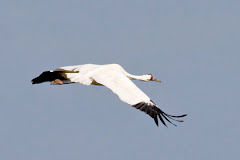It's a busy time of year here at REGI, even without all of the babies of summer. We haven't had time for an update for quite some time so I wanted to share with you just a few of our most recent patients.
Photo above: This Bald Eagle was admitted into our clinic with very high levels of lead in his blood. He has undergone treatments for lead poisoning and is still in critical condition. Each treatment for lead poisoning is a couple thousand dollars and recovery is not guaranteed. We hope that he continues to fight for his life; though he is weak from his illness, he has proven to be a fighter. It is likely that he picked up lead from a deer carcass left from the latest gun-deer season. Cases like this lead poisoned Bald Eagle would be virtually non-existent if hunters and fishermen made the simple switch to lead-free ammunition and fishing tackle.
Photo above: This male American Kestrel was suffering from starvation. His weight has improved a bit and his outlook is very good. He is currently in a flight enclosure regaining muscles necessary for flying and continuing to improve his weight.
Photo above: Two young Trumpeter Swans, also called cygnets, are keeping each other company. The cygnet on the left was admitted in very low weight with a high parasite load. Once the parasites were eliminated we put her in with a "buddy". Trumpeter Swans are highly social birds during non-breeding seasons and benefit from contact with others of the same species. It was amazing to watch her improve once she had some company. She went from not eating at all to eating well on her own. She has some weight to gain yet, but she is showing improvement.
Photo above: An adult Trumpeter Swan, admitted with a wing injury, and a cygnet Trumpeter Swan, suffering from starvation, recover together. Like the two swans above, they find comfort in company. Seeing these two birds side by side provides a great example of the differences between adults and cygnets. Adult trumpeter swans are a beautiful snow white color with a black bill and feet. Juvenile, or cygnet, trumpeter swans are a sooty gray color for their first year with a pinkish bill until their first winter. This cygnet is still gray but his bill has already turned black.
Photo above: This female American Goldfinch was admitted with wounds from a cat bite. She has been treated for the bites and is currently recovering. It is so important for people to keep their cats indoors all year long because protected song birds suffer when the cats invariably hunt them.
Thank You!
It is now near the end of the year and we wanted to take time to thank all of our supporters that have helped us out this year and in the past. Because the birds cannot speak for themselves I will help assist them in thanking you. Thank you to everyone who has donated funds, food (including deer hearts!), and supplies; volunteered time; transported injured birds; and anything else that I may have missed. You have helped us in a huge way! You have provided many sick and injured birds a new lease on life. We truly could not continue without the help of all of you!
You are the wind beneath our wings!
Thank you all!
Karissa Mohr
REGI Wildlife Educator











